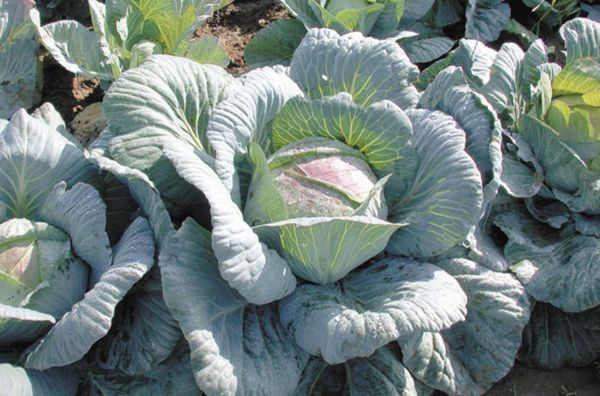Cabbage grows on the site practically each gardener. The most practical are late varieties, for example, Amager. They have fewer problems with growing and are great for storage for the winter.
Table of contents
Description and characteristics of cabbage Amager
Amager is one of the oldest varieties of white cabbage. He was bred in the last century from seeds brought from Switzerland.It is distributed in all regions of the former USSR, with the exception of the Northern and East Siberian.
Given the time of ripening, Amager cabbage variety is considered according to the characteristics late. A heading for the description of a large, dense, has a flat or rounded flat shape. Massoy up to 3 kilograms.
The leaves are solid, dark green with a gray tint, raised, with a wax coating. The shape of the sheet plate is wide and concave, wavy along the edges, the surface is smooth, from the outside it has a slight wrinkle. The inner stalk is small.
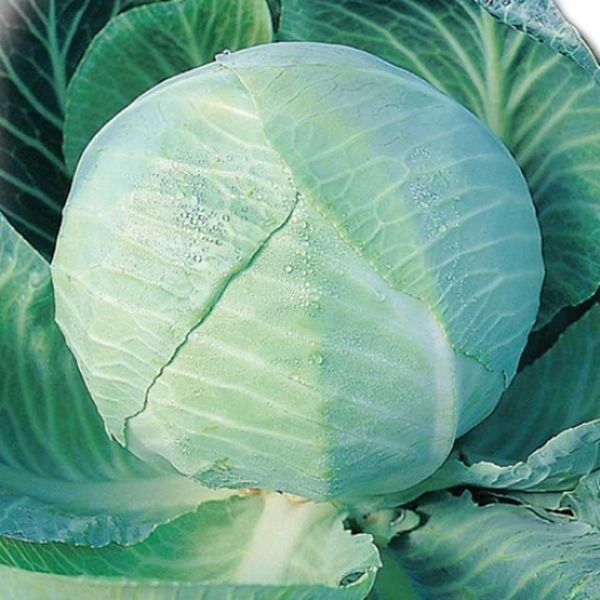
Benefits
Cabbage Amager differs from other varieties such indicators:
- Taste qualities. Improved after several months of storage;
- Resistance to temperature changes. Withstands falling to three degrees of frost, is not afraid of heat.
- Long shelf life in fresh form and suitability for transportation. In comfortable conditions it is saved until April;
- High yield;
- Does not crack due to excess moisture.
disadvantages
It has instability to fusarium wilt - fungal disease affecting tissues (rot of roots, seeds, fruits).
When storing cabbage heads may be covered gray rot or point necrosis in the form of gray spots of various shapes on the outer leaves. To reduce damage to the crop, the storage site and the heads themselves are treated with special means.
Seed preparation for planting
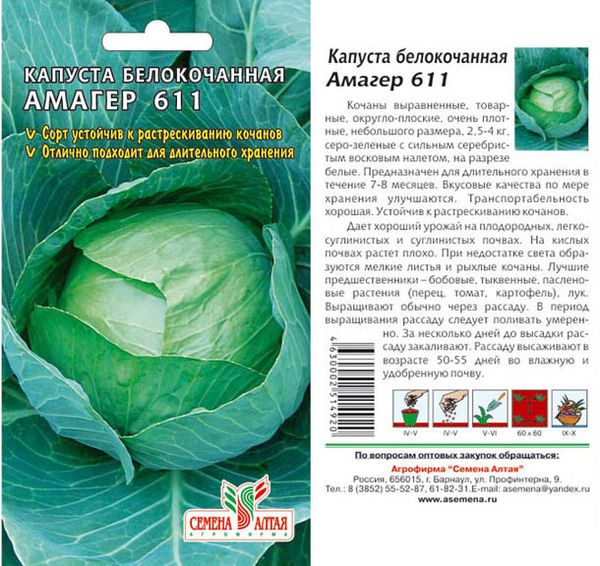
To improve immunity to diseases, seeds treated with phytosporin solution. Soak for 8-10 hours. The same solution disinfects the soil for sowing. This treatment is carried out the day before planting and reduces the risk of various diseases.
Growing seedlings
Sowing is carried out in early April at a depth of up to 2 cm. Cover with foil to create a greenhouse effect. At a temperature of about 20 degrees and good lighting shoots appear on the 4 - 5 day.
After that, seedlings need move to a cooler place. If this is not done, the shoots will begin to stretch, weaken and may die. After 12-15 days, the seedlings swoop into separate containers.Watered once a day with warm water in the morning.
Landing schedule and collection:

In the phase of the third true leaf, the first feeding is carried out, the second - when the fourth leaf appears.
Transfer to the beds
Seedlings with 5-6 true leaves are planted in a permanent place. in the middle of May. Row spacing 60 cmbetween the bushes - 50 cm. Put in the prepared wells, plentifully shed water.
Landing is carried out in the morning or in the evening in warm cloudy weather.
Secrets of care
The main condition for obtaining a good harvest of Amager cabbage is abundant watering. The soil should be sufficiently moist.
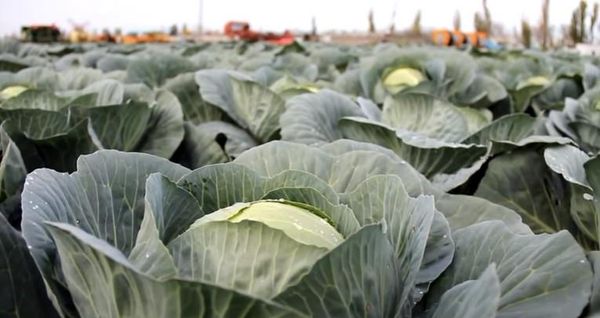
Depending on weather conditions it is recommended to irrigate, on average 2 times per week. To reduce the number of irrigations and retain moisture, a mulch layer is placed under the bushes. It consists of dried grass, fallen leaves or straw.
Late varieties have a weak root system. To strengthen it hold hilling cabbage after watering.
Fertilizer application
For the proper development of the plant it is necessary to make fertilizer. After landing in the ground first feeding spend 15 days with a liquid solution of mineral substances. In a bucket of water, dilute 20 g of potash fertilizer and superphosphate, 10 g of urea. Such a solution contributes to enhanced growth of culture.
A very good remedy is mullein infusion. Prepare it at the rate of: a mullein bucket for ten buckets of water. Insist two days. Bring half a liter under each bush.
Second feeding cabbage spend two weeks after the first. In each hole - one liter. You can reuse mullein or prepare an infusion of chicken droppings in a ratio of 1:25.
Wood ash Sprinkle cabbage leaves to combat pests, in the form of infusion poured at the root. Mineral fertilizers affect the formation of large heads and improve the taste of cabbage.
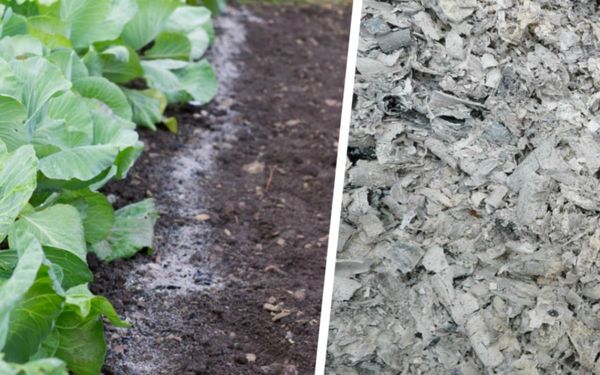
Third time fertilizers are applied after 10 days in the same way. Two weeks before harvesting, cabbage is fed a fourth time to improve storage properties.
Pest and disease control
Sort Amager vulnerable to various diseases and pests. To preserve the crop, depending on the ripening period, chemical poisons and biological preparations are used.
To reduce the likelihood of infection or the spread of disease do the following:
- Diseased cabbage bush needed dig up with the root and destroybetter to burn;
- Process the soil with a five percent solution of copper sulfate. Replace soil in greenhouses;
- Spray with drugs that increase disease resistance - Agat-25, Immunocytofit;
- Use for growing resistant hybrids.
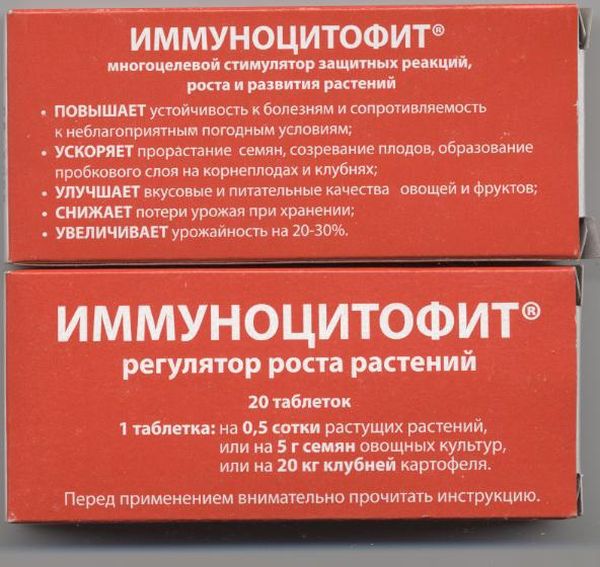
To get rid of aphids, caterpillars and slugs You can folk methods. Wood ash comes to the rescue. Spray it on the leaves, scatter under the root or prepare a solution for watering. In the latter case, it is also an organic fertilizer.
You can alternate with spraying tobacco broth. A liter can of tobacco dust is brewed in two liters of boiling water.Strain, add water to a total of 10 liters.
Harvesting and Storage
Crop harvested depending on ripening. Usually this end of September - October. Cut the cabbies with a knife, leaving a long stalk. Harvesting is best done in dry weather.
Before laying on storage, each head must be inspected. More dense will be stored longer. Excess leaves are recommended to be torn off, dried for several hours in the open air.
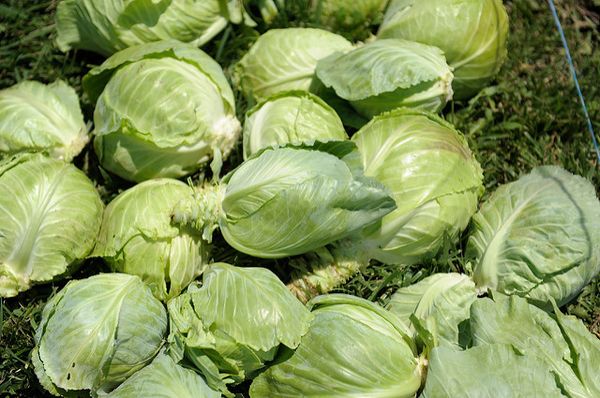
With increased humidity and sudden temperature fluctuations in the storage, favorable conditions are created for the development gray rot. First of all, it affects deformed or frozen cabbage. Affected heads of cabbage are isolated, and storage sites are treated with antifungal drugs.
Growing Amager cabbage, subject to certain rules, does not pose any particular difficulties. The result of constant watering, timely feeding and disease prevention will be a generous harvest that will be stored all winter. Having advantages over other types of cabbage, it is very popular among gardeners.
